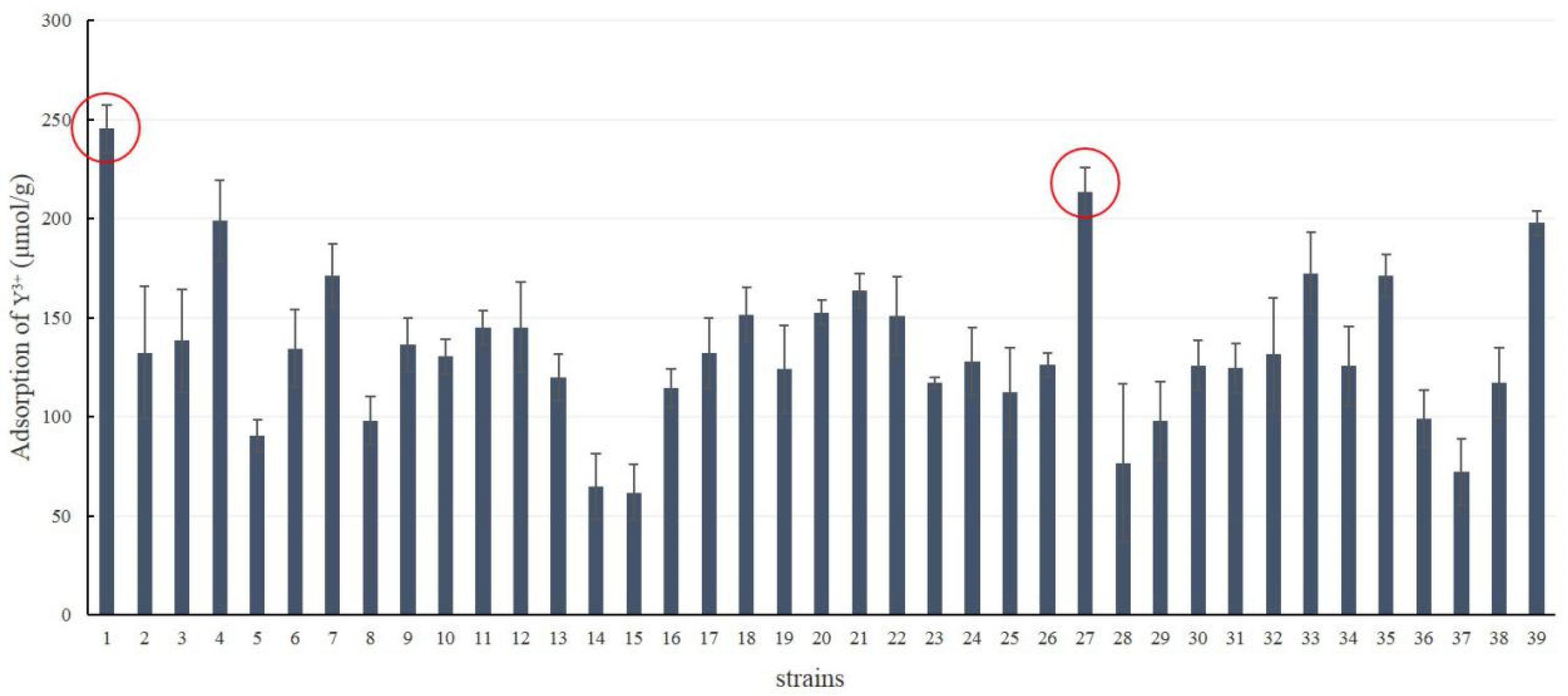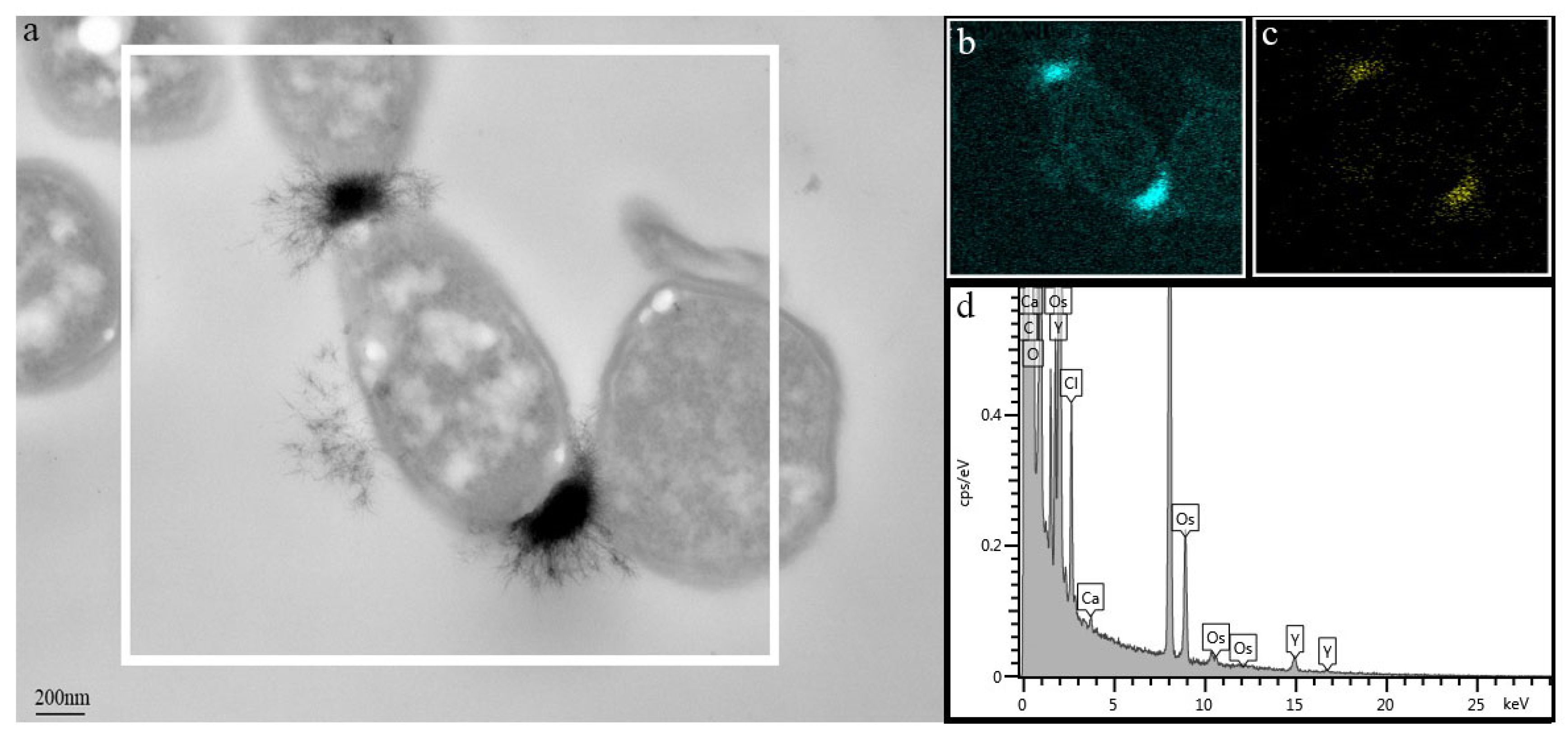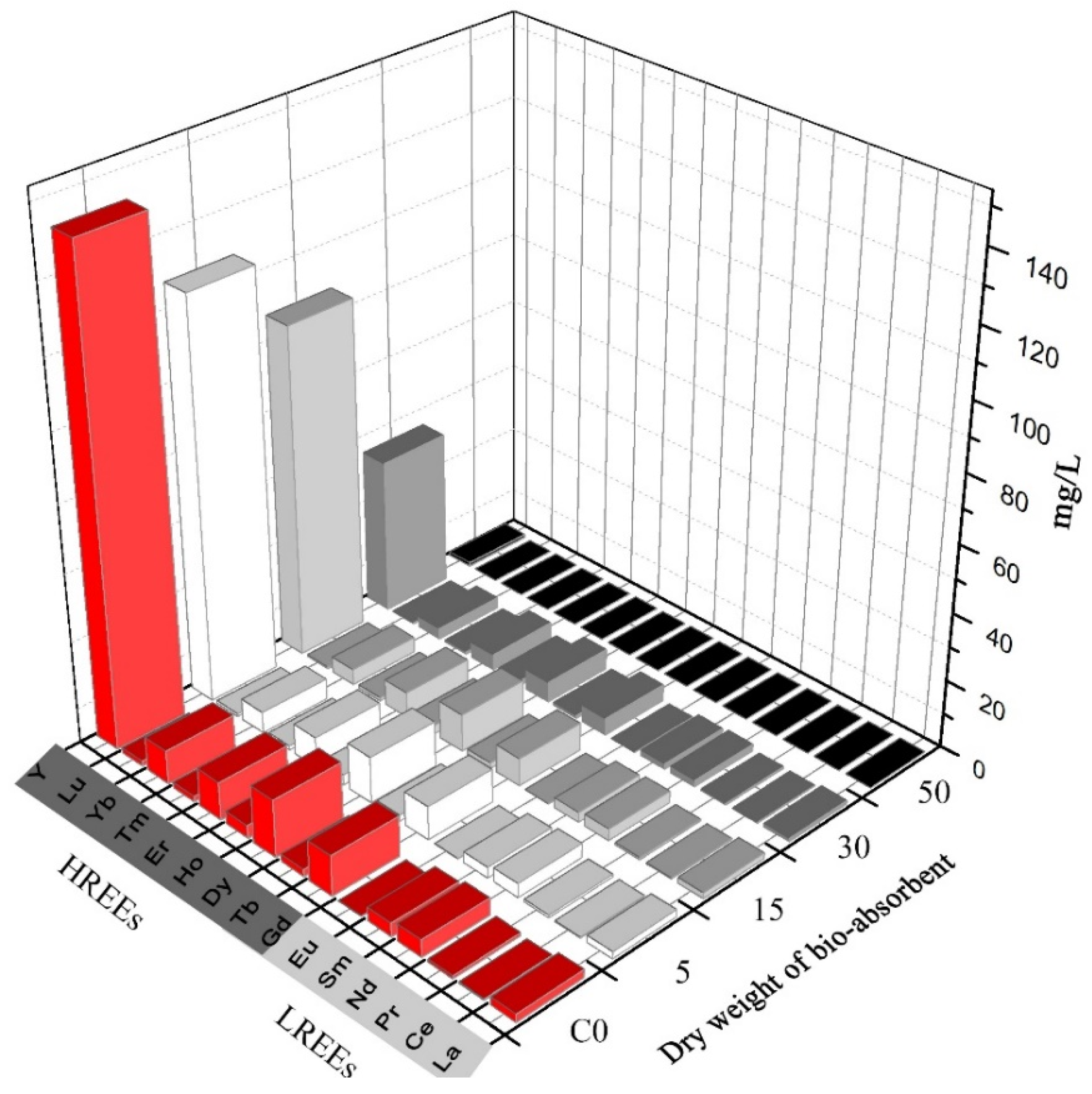New Insights into Ion Adsorption Type Rare-Earths Mining—Bacterial Adsorption of Yttrium Integrated with Ammonia Nitrogen Removal by a Fungus
Abstract
1. Introduction
2. Materials and Methods
2.1. Analysis of Soil Samples in the Mining Area and Rare-Earth Extraction with Ammonium Sulphate
2.2. Screening of Microorganisms for Adsorbing Y3+
2.3. Sequencing of the 16S and 5.8S rRNA Genes
2.4. Adsorption Capacity of No. 1 Bacterium for Y3+ and Rare-Earth Adsorption by the Bacterium from Mother Solution of Mixed Rare Earths
2.5. Determination of Y3+ Concentration
2.6. The Ability of the Fungus to Degrade Ammonia Nitrogen and Wastewater Treatment
2.6.1. The Ability of the Fungus to Degrade Ammonia Nitrogen
2.6.2. Design of a Uniform Experiment
3. Results and Discussion
3.1. Strain Screening
3.2. Adsorption of Bacillus sp. ZD1 for Y3+ at Different Concentrations
3.3. Prepared Mother Solution of Mixed Rare-Earth Ions and Bacterial Adsorption for Rare-Earth Ions
3.4. The Removal of Ammonia Nitrogen by Galactomyces sp. ZD27
3.5. Optimisation Design of Degradation of No. 27 Fungus on Ammonia-Nitrogen Wastewater
4. Conclusions
Supplementary Materials
Author Contributions
Funding
Institutional Review Board Statement
Informed Consent Statement
Data Availability Statement
Acknowledgments
Conflicts of Interest
References
- Alonso, E.; Sherman, A.M.; Wallington, T.J.; Everson, M.P.; Field, F.R.; Roth, R.; Kirchain, R.E. Evaluating rare earth element availability: A case with revolutionary demand from clean technologies. Environ. Sci. Technol. 2012, 46, 3406–3614. [Google Scholar] [CrossRef]
- Stone, R. As China’s Rare Earth R&D becomes ever more rarefied, others tremble. Science 2009, 325, 1336–1337. [Google Scholar] [PubMed]
- Yang, G.M. Mineral Geology of China, Dossier of Jiangxi; Geology Press: Beijing, China, 2015. [Google Scholar]
- Zhuang, W.Q.; Fitts, J.P.; Ajo-Franklin, C.M.; Maes, S.; Alvarez-Cohen, L.; Hennebel, T. Recovery of critical metals using biometallurgy. Curr. Opin. Biotechnol. 2015, 33, 327–335. [Google Scholar] [CrossRef] [PubMed]
- US Department of Energy. Critical Materials Strategy. Available online: http://energy.gov/sites/prod/files/DOE_CMS2011_FINAL_Full.pdf (accessed on 20 December 2011).
- Zhu, H.L.; Yao, J. Study on the application of ammonia nitrogen wastewater treatment process in southern ionic rare earth mine area. Mod. Min. 2019, 602, 13–16. [Google Scholar]
- Feng, A.J.; Xiao, X.; Ye, C.C.; Xu, X.M.; Zhu, Q.; Yuan, J.P.; Hong, Y.H.; Wang, J.H. Isolation and characterization of Burkholderia fungorum Gan-35 with the outstanding ammonia nitrogen-degrading ability from the tailings of rare-earth-element mines in southern Jiangxi, China. AMB Expr. 2017, 7, 140. [Google Scholar] [CrossRef]
- Johnson, D.B. Biomining–biotechnologies for extracting and recovering metals from ores and waste materials. Curr. Opin. Biotech. 2014, 30, 24–31. [Google Scholar] [CrossRef] [PubMed]
- Brierley, C.L.; Brierley, J.A. Progress in bioleaching: Part B: Applications of microbial processes by the minerals industries. Appl. Microbiol. Biotechnol. 2013, 97, 7543–7552. [Google Scholar] [CrossRef]
- Kucuker, M.A.; Kuchta, K. Biomining–biotechnological systems (bioleaching and biosorption) for the extraction and recovery of metals from secondary sources. In Proceedings of the 15th International Conference on Environmental Science and Technology, Rhodes, Greece, 31 August–2 September 2017. [Google Scholar]
- Cheng, Y.; Zhang, L.; Bian, X.; Zuo, H.; Dong, H. Adsorption and mineralization of REE-lanthanum onto bacterial cell surface. Environ. Sci. Pollut. Res. Int. 2017, 25, 22334–22339. [Google Scholar] [CrossRef]
- Bonificio, W.D.; Clarke, D.R. Rare-earth separation using bacteria. Environ. Sci. Technol. Lett. 2016, 3, 180–184. [Google Scholar] [CrossRef]
- Tsuruta, T. Accumulation of rare earth elements in various microorganisms. J. Rare Earth 2007, 25, 526–532. [Google Scholar] [CrossRef]
- Markai, S.; Andre’s, Y.; Montavon, G.; Grambow, B. Study of the interaction between europium (III) and Bacillus subtilis: Fixation sites, biosorption modeling and reversibility. J. Colloid Interf. Sci. 2003, 262, 351–361. [Google Scholar] [CrossRef]
- Wang, W.; Xu, C.; Jin, Y.; Zhang, Z.; Zhu, D. The accumulation of rare-earth yttrium ions by Penicillium sp. ZD28. AMB Express 2020, 10, 25. [Google Scholar] [CrossRef]
- Gupta, V.K.; Sadegh, H.; Yari, M.; Ghoshekandi, R.S.; Maazinejad, B.; Chahardori, M. Removal of ammonium ions from wastewater: A short review in development of efficient methods. Glob. J. Environ. Sci. Manag. 2015, 1, 149–158. [Google Scholar]
- Breisha, G.Z.; Winter, J. Bio-removal of nitrogen from wastewaters—a review. Nat. Sci. 2010, 8, 210–228. [Google Scholar]
- Schmidt, I.; Sliekers, O.; Schmid, M.; Bock, E.; Fuerst, J.; Kuenen, J.G.; Jetten, M.S.M.; Strous, M. New concepts of microbial treatment processes for the nitrogen removal in wastewater. FEMS Microbiol. Rev. 2003, 27, 481–492. [Google Scholar] [CrossRef]
- Chen, Q.; Ni, J.R. Ammonium removal by Agrobacterium sp. LAD9 capable of heterotrophic nitrification– aerobic denitrification. J. Biosci. Bioeng. 2012, 113, 619–623. [Google Scholar] [CrossRef] [PubMed]
- Laughlin, R.J.; Rütting, T.; Müller, C.; Watson, C.J.; Stevens, R.J. Effect of acetate on soil respiration, N2O emissions and gross N transformations related to fungi and bacteria in a grassland soil. Appl. Soil Ecol. 2009, 42, 25–30. [Google Scholar] [CrossRef]
- Laughlin, R.J.; Stevens, R.J.; Müller, C.; Watson, C.J. Evidence that fungi can oxidize NH4+ to NO3- in a grassland soil. Eur. J. Soil Sci. 2008, 59, 285–291. [Google Scholar] [CrossRef]
- Chi, R.A.; Tian, J. Weathered Crust Elution-Deposited Rare Earth Ores; Nova Science Publishers: New York, NY, USA, 2008. [Google Scholar]
- Hogendoorn, C.; Roszczenko-Jasińska, P.; Martinez-Gomez, N.C.; Graaff, J.; Grassl, P.; Pol, A.; Op den Camp, H.; Daumann, L. Facile arsenazo iii-based assay for monitoring rare earth element depletion from cultivation media for methanotrophic and methylotrophic bacteria. Appl. Environ. Microbiol. 2018, 84, e02887-17. [Google Scholar] [CrossRef]
- Liu, Z.; Liu, G.; Cai, H.; Shi, P.; Chang, W.; Zhang, S.; Zheng, A.; Xie, Q.; Ma, J. Paecilomyces variotii: A fungus capable of removing ammonia nitrogen and inhibiting ammonia emission from manure. PLoS ONE 2016, 11, e0158089. [Google Scholar] [CrossRef] [PubMed][Green Version]
- Kelly, S.D.; Kemner, K.M.; Fein, J.B.; Fowle, D.A.; Boyanov, M.I.; Bunker, B.A.; Yee, N. X-ray absorption fine structure determination of pH-dependent U-bacterial cell wall interactions. Geochim. Cosmochim. Acta 2002, 66, 3855–3871. [Google Scholar] [CrossRef]
- Boyanov, M.I.; Kelly, S.D.; Kemner, K.M.; Bunker, B.A.; Fein, J.B.; Fowle, D.A. Adsorption of cadmium to Bacillus subtilis bacterial cell walls: A pH-dependent X-ray absorption fine structure spectroscopy study. Geochim. Cosmochim. Acta 2003, 67, 3299–3312. [Google Scholar] [CrossRef]
- Mullen, M.D.; Wolf, D.C.; Ferris, F.G.; Beveridge, T.J.; Flemming, C.A.; Bailey, G.W. Bacterial sorption of heavy metals. Appl. Environ. Microbiol. 1989, 55, 3143–3149. [Google Scholar] [CrossRef] [PubMed]
- Texier, A.C.; Andrès, Y.; Cloirec, P.L. Selective biosorption of lanthanide (La, Eu, Yb) ions by Pseudomonas aeruginosa. Environ. Sci. Technol. 1999, 33, 489–495. [Google Scholar] [CrossRef]
- Zhao, C.M.; Wilkinson, K.J. Biotic ligand model does not predict the bioavailability of rare earth elements in the presence of organic ligands. Environ. Sci. Technol. 2015, 49, 2207–2214. [Google Scholar] [CrossRef]
- Takahashi, Y.; Kondo, K.; Miyaji, A.; Watanabe, Y.; Fan, Q.; Honma, T.; Tanaka, K. Recovery and separation of rare earth elements using salmon milt. PLoS ONE 2014, 9, e114858. [Google Scholar] [CrossRef]
- Mao, J.; Won, S.W.; Vijayaraghavan, K.; Yun, Y.S. Surface modification of Corynebacterium glutamicum for enhanced reactive red 4 biosorption. Bioresour. Technol. 2009, 100, 1463. [Google Scholar] [CrossRef]
- Li, D.; Li, R.Y.; Ding, Z.X.; Ruan, X.F.; Luo, J.; Chen, J.Y.; Zheng, J.; Tang, J.X. Discovery of a novel native bacterium of Providencia sp. with high biosorption and oxidation ability of manganese for bioleaching of heavy metal contaminated soils. Chemosphere 2020, 241, 125039. [Google Scholar]
- Kumar, V.; Singh, S.; Singh, G.; Dwivedi, S.K. Exploring the cadmium tolerance and removal capability of a filamentous fungus Fusarium solani. Geomicrobiol. J. 2019, 36, 782–791. [Google Scholar] [CrossRef]
- Romero-Gonzalez, M.E.; Williams, C.J.; Gardiner, P.H.E. Study of the mechanisms of cadmium biosorption by dealginated seaweed waste. Environ. Sci. Technol. 2001, 35, 3025–3030. [Google Scholar] [CrossRef]
- Chen, C.; Wang, J. Influence of metal ionic characteristics on their biosorption capacity by Saccharomyces cerevisiae. Appl. Microbiol. Biotechnol. 2007, 74, 911–917. [Google Scholar] [CrossRef]
- Özdemir, S.; Kilinc, E.; Poli, A.; Nicolaus, B.; Güven, K. Biosorption of Cd, Cu, Ni, Mn and Zn from aqueous solutions by thermophilic bacteria, Geobacillus toebii sub. sp. decanicus and Geobacillus thermoleovorans sub. sp. stromboliensis: Equilibrium, kinetic and thermodynamic studies. Chem. Eng. J. 2009, 152, 195–206. [Google Scholar]
- Aller, A.J.; Castro, M.A. Live bacterial cells as analytical tools for speciation analysis: Hypothetical or practical? Trac-Trends Anal. Chem. 2006, 25, 887–898. [Google Scholar] [CrossRef]
- Li, J.; Liu, Y.L.; Zhang, L.M.; He, J.Z. Sorption mechanism and distribution of cadmium by different microbial species. J. Environ. Manag. 2019, 237, 552–559. [Google Scholar] [CrossRef]
- Zhang, J.H.; Li, Q.; Zeng, Y.F.; Zhang, J.; Lu, G.N.; Dang, Z.; Guo, C.L. Bioaccumulation and distribution of cadmium by Burkholderia cepacia GYP1 under oligotrophic condition and mechanism analysis at proteome level. Ecotox. Environ. Saf. 2019, 176, 162–169. [Google Scholar] [CrossRef] [PubMed]
- Lee, J.; Pandey, B. Bio-processing of solid wastes and secondary resources for metal extraction–a review. Waste Manag. 2012, 32, 3–18. [Google Scholar] [CrossRef]
- Bharadwaj, A.; Ting, Y. From biomining of mineral ores to bio urban mining of industrial waste. In Proceedings of the Environmental Technology Management Conference 4th ETMC, Bandung, Indonesia, 3–4 November 2011. [Google Scholar]
- Yang, X.; Wang, S.; Zhou, L. Effect of carbon source, C/N ratio, nitrate and dissolved oxygen concentration on nitrite and ammonium production from denitrification process by Pseudomonas stutzeri D6. Bioresour. Technol. 2012, 104, 65–72. [Google Scholar] [CrossRef] [PubMed]
- Joo, H.S.; Hirai, M.; Shoda, M. Characteristics of ammonium removal by heterotrophic nitrification-aerobic denitrification by Alcaligenes faecalis No. 4. J. Biosci. Bioeng. 2005, 100, 184–191. [Google Scholar] [CrossRef]
- Lu, Y.K.; Niu, F.L.; Liu, Y.X.; Zhang, L. Isolation and characteristic of a new heterotrophic nitrification fungus. J. Taiyuan Univ. Technol. 2015, 46, 129–133. [Google Scholar]
- Yang, L.; Chen, N.; Ren, Y.; Cui, S.; Wang, X.; Xiao, Q.; Guo, L. Simultaneous nitrogen and phosphorus removal and kinetics by the heterotrophic nitrifying bacterium Acinetobacter junii NP1. Environ. Sci. 2019, 40, 3713–3720. [Google Scholar]
- Gao, J.; He, T.; Cheng, X.; Feng, L.; Zhang, L. Performance of the combined EGSB-MBR reactor treating fermentation wastewater. China Environ. Sci. 2015, 35, 1416–1422. [Google Scholar]
- Shen, P.; Han, F.; Su, S.; Zhang, J.; Chen, Z.; Li, J.; Gan, J.; Feng, B.; Wu, B. Using pig manure to promote fermentation of sugarcane molasses alcohol wastewater and its effects on microbial community structure. Bioresour. Technol. 2014, 155, 323–329. [Google Scholar] [CrossRef]






| Num. of Experiments | X1 Concn. of NH4+-N (mg/L) | X2 C/N | X3 Concn. of Phosphorus (mg/L) |
|---|---|---|---|
| 1 | 50 | 5 | 60 |
| 2 | 100 | 20 | 200 |
| 3 | 150 | 40 | 40 |
| 4 | 200 | 2.5 | 160 |
| 5 | 300 | 10 | 20 |
| 6 | 400 | 30 | 80 |
| Sorption (μmol·g−1) with an Initial Concentration of Y3+ | |||
|---|---|---|---|
| 0.09 mM | 0.48 mM | 1.13 mM | |
| adsorption capacity | 90 (±13) | 299 (±30) | 428 (±81) |
| removal percentage | 100% | 62% | 38% |
| Cultivation Time (h) | Initial NH4+-N (mg/L) | Final NH4+-N (mg/L) | Removal Percentage (%) |
|---|---|---|---|
| 20 | 242.66 (±15.28) | 14.10 (±4.40) | 94.42 |
| 20 | 493.77 (±19.57) | 154.34 (±31.06) | 68.55 |
| 46 | 778.54 (±103.49) | 333.59 (±27.06) | 56.91 |
| 46 | 1364.61 (±20.18) | 1051.87 (±66.17) | 22.95 |
| 70 | 1795.58 (±7.63) | 1517.16 (±53.39) | 15.50 |
| 100 | 2587.59 (±66.64) | 2086.70 (±78.37) | 19.34 |
Publisher’s Note: MDPI stays neutral with regard to jurisdictional claims in published maps and institutional affiliations. |
© 2021 by the authors. Licensee MDPI, Basel, Switzerland. This article is an open access article distributed under the terms and conditions of the Creative Commons Attribution (CC BY) license (https://creativecommons.org/licenses/by/4.0/).
Share and Cite
Wang, W.; Xu, Y.; Yan, R.; Zhang, Z. New Insights into Ion Adsorption Type Rare-Earths Mining—Bacterial Adsorption of Yttrium Integrated with Ammonia Nitrogen Removal by a Fungus. Sustainability 2021, 13, 9460. https://doi.org/10.3390/su13169460
Wang W, Xu Y, Yan R, Zhang Z. New Insights into Ion Adsorption Type Rare-Earths Mining—Bacterial Adsorption of Yttrium Integrated with Ammonia Nitrogen Removal by a Fungus. Sustainability. 2021; 13(16):9460. https://doi.org/10.3390/su13169460
Chicago/Turabian StyleWang, Weiying, Yanqiong Xu, Riming Yan, and Zhibin Zhang. 2021. "New Insights into Ion Adsorption Type Rare-Earths Mining—Bacterial Adsorption of Yttrium Integrated with Ammonia Nitrogen Removal by a Fungus" Sustainability 13, no. 16: 9460. https://doi.org/10.3390/su13169460
APA StyleWang, W., Xu, Y., Yan, R., & Zhang, Z. (2021). New Insights into Ion Adsorption Type Rare-Earths Mining—Bacterial Adsorption of Yttrium Integrated with Ammonia Nitrogen Removal by a Fungus. Sustainability, 13(16), 9460. https://doi.org/10.3390/su13169460





